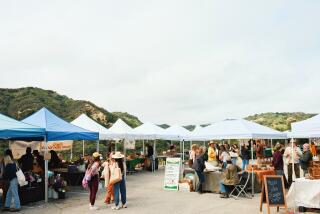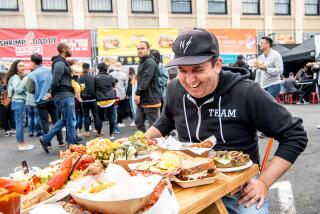Farmers market manager also its char man
When the breeze blows in the right direction, a spicy vegetal aroma tells visitors to the Santa Monica Virginia Park farmers market that Ted Galván, the manager, is roasting chile peppers. Each Saturday in September, he takes pasilla, Anaheim and jalapeño peppers grown by Tutti Frutti Farms in Lompoc, chars them in a tumbler rotating over propane flames and sells them to the public.
The deep green pasillas (properly known as poblanos but often called pasillas in California) are broad and have thick walls, and are typically stuffed to make chiles rellenos, says Galván, who used to own a mini-chain of Mexican restaurants. Anaheim peppers, light green, long and fairly mild, are New Mexican-type chiles, great in eggs, quesadillas and sandwiches. When the pods are blistered, the tough transparent outer skins separate from the meat of the chile and are readily scrubbed off.
Coastal Hass avocados
Late summer and early fall is a tricky time for buying avocados at farmers markets. Hass from northern San Diego County, which was at peak quality in spring and early summer, is still available from many vendors but is likely to be over the hill by now. If you buy from the same farm, it’s easy to overlook the signs of over-maturity, because they develop so gradually, but currently they’re unmistakable: the skin is thin and crumbly, often with soft black “Hass spots” underneath it; the seed may be starting to sprout (“let me outta here!” it seems to be saying); the flesh is deep yellow, ripens very quickly to a mushy texture and, most important, has a cooked, rancid flavor.
The solution is the one inland Californians have employed for generations to beat the heat: Head to the Central Coast. Hass from cool northern coastal districts mature much more slowly than fruit from hotter areas and are likely to remain in good condition well into the fall. Moreover, the fruit continues to accumulate oil, and so becomes delightfully rich and creamy.
Rancho Santa Cecelia of Carpinteria offers reasonably priced Hass in several sizes in their signature yellow tubs at the Burbank, Hollywood, Echo Park and Torrance farmers markets.
For the ultimate, premium avocado in late season, look for fruit from Morro Bay, the most northerly and coolest coastal district. Michael Cirone, who sells at the Santa Monica downtown markets on Saturdays and Wednesdays, has a good crop this year. His avocados have developed a cult following, so arrive early to score.
For years Jim Shanley, who grows avocados in Morro Bay, winced as his pristine late-season Hass were sold indiscriminately at stores with over-mature southern fruit, like Rolls-Royces commingled with Yugos. This season he launched a brand, Morro Bay Avocados, to market his fruit as a premium product; it will be available at Southern California Whole Foods stores through October, at $2.49 each for medium-size fruits. Gelson’s will have large fruit by this weekend at the Century City store.
Ironically, this was the one year that Shanley might have done better to strip his trees early, because a short California crop saw prices reach record heights this summer, up to $60 wholesale for a 25-pound box, about twice the typical price in previous years. But now avocados imported from Chile, Peru and Mexico are flooding into the market, and the wholesale price for Mexican fruit has dipped below $40, said Shanley. Prices at both farmers markets and supermarkets, which have been extremely high — up to $3 or even $4 a fruit — should eventually head back down to earth.
Rutab Barhi dates
Dates, which are now in prime season, may seem interchangeably sweet, but preferences for varieties and textures can be deeply felt among true aficionados. Firm, crunchy, yellow Barhi dates in the khalal stage, the first edible phase for this variety, have been in markets for a month, but until recently they have been too astringent to be fully agreeable to my palate. Now the sweetness and astringency are in perfect balance, and when set out on the kitchen counter, the fruit will more dependably ripen to the soft rutab stage.
Eating a rutab Barhi, plump, tender and translucent golden brown, is an exquisite treat, like biting into a caramel cloud. If the calyx, the round button at the end where the stem was attached, still adheres to the fruit, it is often possible to hold the date between one’s lips and pull out the seed by the calyx. At this point the fruit is so soft and perishable that it is difficult to ship or store, so it is rare to find outside of farmers markets and local Mideastern groceries. The old maxim “a good date is a cold date” particularly applies to rutab Barhis, which are best stored in the refrigerator if they will be kept for more than a few days.
Barhis will still be available for many months but gradually mature into the third, more dried-down tamar stage. The pulp is firmer and just as delicious, but as it dries it pulls away from the skin, which becomes hard and papery, and diminishes the appeal compared with the more delicate rutab stage.
Everett DaVall, whose family helped pioneer date growing in the Coachella Valley a century ago, sells large, plump, perfectly ripe rutab Barhis grown in Indio at the Pasadena (Victory Park), Irvine (Sept. 17 and every other Saturday), Studio City, Hollywood and Santa Monica (Wednesday and Saturday downtown) farmers markets.
More to Read
Eat your way across L.A.
Get our weekly Tasting Notes newsletter for reviews, news and more.
You may occasionally receive promotional content from the Los Angeles Times.






